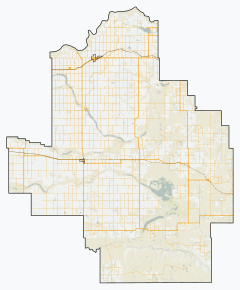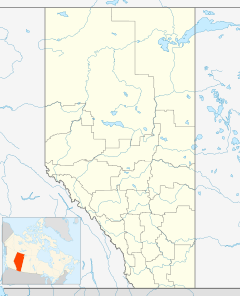Whitla, Alberta facts for kids
Quick facts for kids
Whitla
|
|
|---|---|
|
Hamlet
|
|
| Country | Canada |
| Province | Alberta |
| Region | Southern Alberta |
| Census division | No. 1 |
| Municipal district | County of Forty Mile No. 8 |
| Government | |
| • Type | Unincorporated |
| Elevation | 791 m (2,595 ft) |
| Time zone | UTC-7 (Mountain Time Zone) |
| • Summer (DST) | UTC-6 (Mountain Time Zone) |
Whitla is a small community called a hamlet in Alberta, Canada. It's part of the County of Forty Mile No. 8.
Whitla is located about 32 km (20 mi) southwest of the city of Medicine Hat. It's also just 1.6 km (0.99 mi) north of Highway 3. In December 2021, Capital Power Corporation finished building Alberta's largest wind farm here. This farm can produce 353 megawatts of power!
Contents
Whitla's Early Days
Whitla, like many towns nearby, started when land became available for homesteaders in 1908. But there was some activity even before that. The area was named after R.J. Whitla, a Winnipeg merchant. He visited the site in 1885 when it was just a small siding (a short track for trains).
Even earlier, in 1884, some squatters (people who settled on land without permission) and cattle ranchers had already moved into the area. Back then, Medicine Hat was the main trading center. But when the Turkey Track railway was built, a community began to grow around the village of Seven Persons.
Settlers Arrive
In 1909, hundreds of settlers came to the Whitla area from North Dakota. They were encouraged by exciting, but sometimes untrue, promises from real estate agents and government ads. These new settlers brought their traditions with them. For example, they celebrated the Fourth of July instead of Canada's July 1st. They also introduced oxen to the short-grass plains.
The first merchant to settle in Whitla was Sam Richardson, who arrived in 1909. Before him, Whitla only had the railway siding, a section house (a building for railway workers), and a dugout (a simple shelter) for the track workers. Richardson built a store using lumber shipped from Medicine Hat. Behind it, he built a small shack for his family.
Growing Pains
The next year, Alex and Chris Ashton opened another general store on the north side of the railway tracks. Soon after, a hardware store, a lumber yard, and a farm machinery company also opened. The Ashton store burned down in January 1916, but the town kept growing quickly. Whitla soon had a Union Bank, two cafes, a billiard hall, and three garages.
The settlers and residents of Whitla faced similar challenges to their neighbors in Winnifred. By 1924, the Alberta Government offered to help any homesteader who wanted to leave the area. Many people accepted this help. In 1927 and 1928, there were two great harvests, and Whitla saw a boom. However, the next twelve years brought a lot of hardship.
Hard Times and Changes
The Dirty Thirties were a very difficult time. There were many dry years, which meant crops failed. There were also huge numbers of grasshoppers, lots of rabbits, and terrible dust storms. Carl Larson, in his book Tribute to Whitla Pioneers, remembered a dust storm so bad that people saw grasshoppers digging holes four feet above the ground.
People started leaving Whitla as early as 1920, but this movement sped up during the 1930s and early 1940s. By the end of World War II, most of the small homesteads were gone. They were replaced by much larger farms and ranches. In 1949, Highway 3 was paved and moved, bypassing the town. This was a big blow to Whitla's economy, just as it was for other towns that modern highways bypassed.
New Hope and Decline
The mid-1950s brought some hope for improvement. Electricity arrived in 1955. The next year, irrigation began from the St. Mary River Project. The local dam, located north of Whitla, was named Rattlesnake Dam. Unfortunately, this irrigation came about 40 years too late for many of the original settlers.
The 1960s saw Whitla slowly decline. The school closed in 1964, which was a clear sign of the town's struggles. For a short time after that, the town's grain elevators (tall buildings for storing grain) continued to operate. However, they were destroyed in the mid-1990s.



